Table of Contents Hide
- 1 Optical Radiation Hazards
- 2 Why Is LED Technology under Unprecedented Scrutiny with Regard to Human Health
- 3 What Are Blue-pump LEDs
- 4 Lamp Safety Groups
- 5 What Is Blue Light Hazard
- 6 Do LEDs Emit More Blue Light? No!
- 7 The Exaggerated BLH Concern
- 8 Blue Light Is Vital
- 9 Artificial Lighting and Circadian Disruption
- 10 LED Lighting Should Not Be the Scapegoat of Circadian Disruption
- 11 Simulating Natural Lighting Dynamics with LED Lighting
Lamps and light fixtures that incorporate white LED sources have been employed ubiquitously in residences, offices, commercial buildings, industrial facilities, and a host of other environments as energy efficient alternatives to less efficient products. Since Edison's invention of incandescent bulbs electric lighting have gone through various generations of development. While LED technology gained mainstream attention for its incomparable efficiency, lifespan, controllability and durability advantages, a focus has been placed on the safety of LED lighting with regard to human health. Recently there is a surge of debates on the photobiological safety and biological impact of LED lighting. Some are reasonable skepticisms, yet some are unsubstantiated suppositions that deliberately exaggerate the sensitive characteristics of LEDs so as to attract eyeballs.

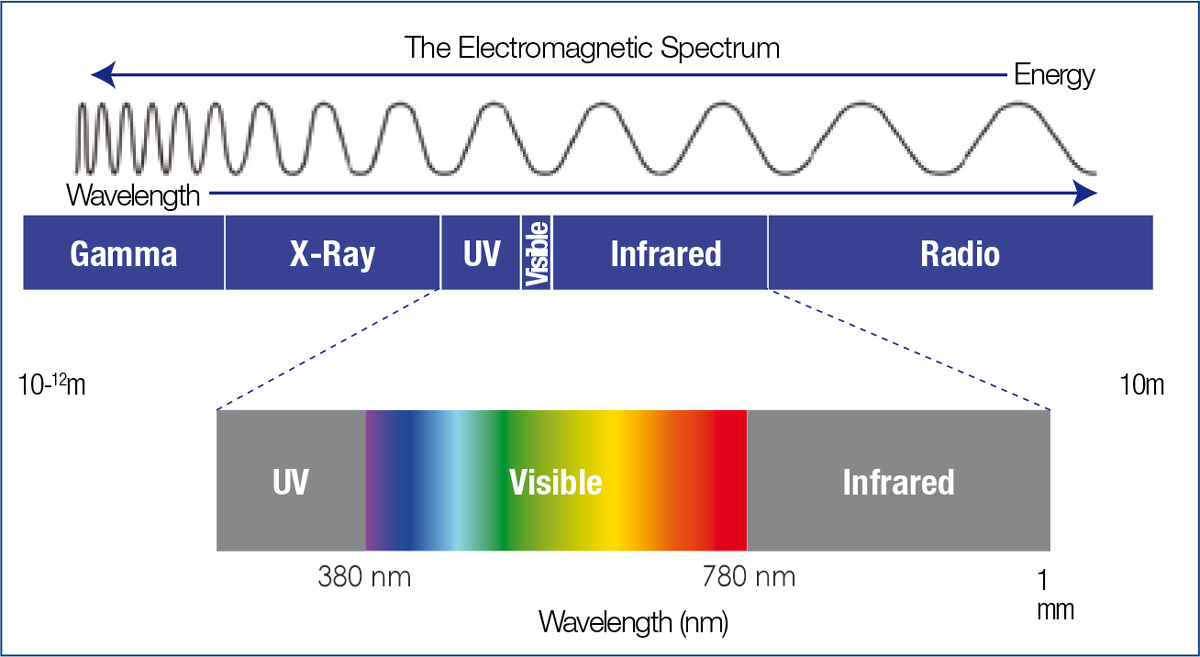
As semiconductor devices, LEDs were originally included in the scope of the laser safety standard IEC 60825 in Europe and other IEC oriented countries, which gave a misconception that LED lighting was as dangerous as laser lighting and thus often led to an overestimation of the risks. Since 2009 LEDs are tested to the IEC 62471 standard as with all other lamps and luminaires.
The main ground of those misinformed claims is that the electromagnetic spectrum of blue-pump LEDs has a narrow peak in the short wavelength blue region. This blue peak, which is more prominent in higher-CCT LEDs, can be easily misinterpreted as suggesting an abnormally high blue content.
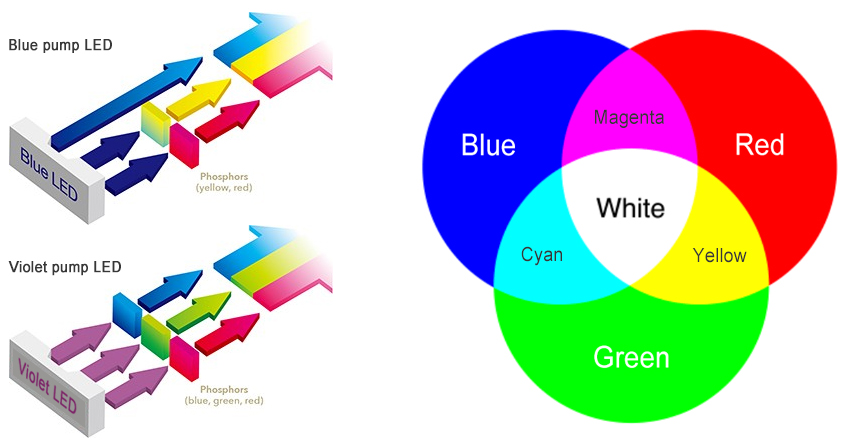
Risk Group 0 (RG0, Exempt Group)
The lamp poses no photobiological hazard. The requirement is met by any lamp that does not pose an actinic ultraviolet hazard within 8 hours' exposure, nor a near-ultraviolet hazard nor an infrared cornea/lens hazard within 1,000s, nor retinal thermal hazard within 10 s, nor a blue-light hazard within 10,000 s (about 2.8 hours), and lamps that emit infrared radiation without a strong visual stimulus and do not pose a near-infrared retinal hazard within 1,000 s are in the Exempt group.
Because of the UV- and IR-free spectral nature of LED optical radiation, the only assessed item for LED lamps and light fixtures in IEC/IES lamp safety classifications is blue light hazard. Blue light hazard (BLH) is defined as the potential for a photochemically induced retinal injury resulting from radiation exposure to high-energy, short-wavelength light in the violet and blue range of the spectrum (between 400 and 500 nm). Blue light radiation on the eye can induce production of reactive oxygen species (ROS) which attacks many molecules, including retinal pigment epithelium (RPE) cells that are essential to the regeneration of visual pigments, supply the photoreceptors with nutrients and oxygen, and help maintain the homeostasis of photoreceptors. Excessive oxidative stress leads to RPE apoptosis which eventually causes the rod and cone photoreceptors to degenerate. Blue light photoactivation has been implicated in the pathogenesis of age-related macular degeneration (AMD), a degenerative retinal disease.
By far the most hazardous light source is the sun, which not only produces optical radiation in both the infrared and ultraviolet regions of the electromagnetic spectrum, but also contains a high percentage of blue (25% - 30% of the total radiant energy) in its visible light spectrum. When looking directly into the sun, a photochemical damage to the retina is likely to occur. Fortunately, we have natural aversion responses that protect the eye against injury from viewing very bright light. There's a threshold radiance, irradiance, and duration of exposure for oxidative photoactivation of blue light. For example, the blue wavelengths of sunlight gives the sky its blue appearance, but there's no risk of retinal injuries exposing the eye to skylight because the scattered blue light in skylight isn't potent enough to induce photochemical reaction in the retina.
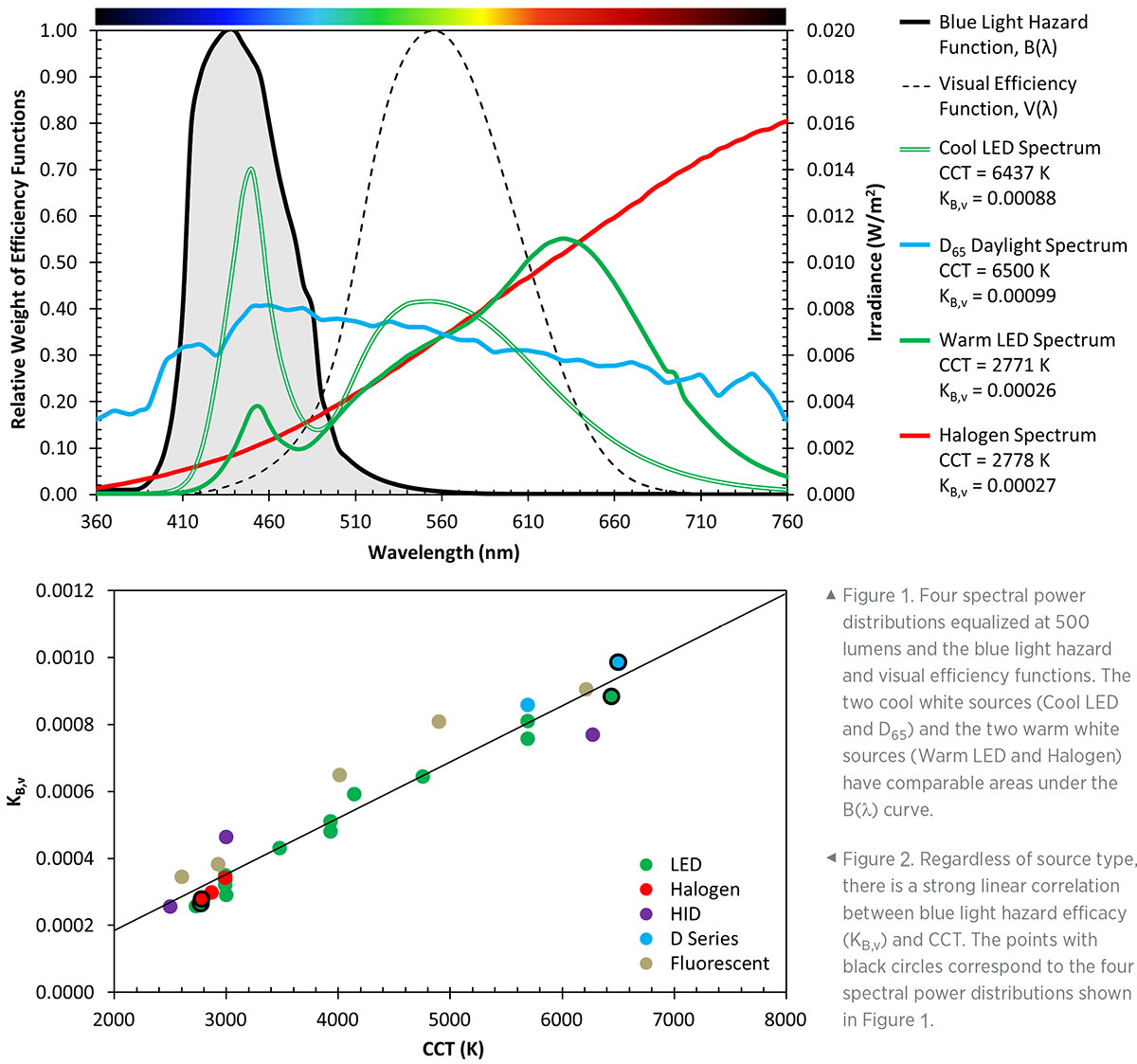
Most people don't take the color temperature of a light source seriously. In fact, the role of CCT in lighting is far more important than most people would ever imagine. Not only does it visually and psychologically affect the illuminated environment, the choice of CCT, together with light intensity, establishes the photobiological damage potential of a light source. Light at any given wavelength, including the short wavelength blue, is the same regardless of what the light source emitted from. On the whole, the higher the CCT is, the more blue light content is contained in the spectrum, be it LED, fluorescent, or HID lamps. There's evidently a strong linear correlation between blue light damage potential and CCT regardless of the source type. According to IEC TR 62778, the threshold for illuminance that potentially contributes to an RG2 hazard is around 1000 lux for a 6500 K cool white light source, and 5000 lux for a 2700 K warm white light source. The threshold for luminance that may lead to a hazard classification of RG2 is 10 Mcd/m2 for a 6500 K cool white light source, and 32 Mcd/m2 for a 2700 K warm white light source.
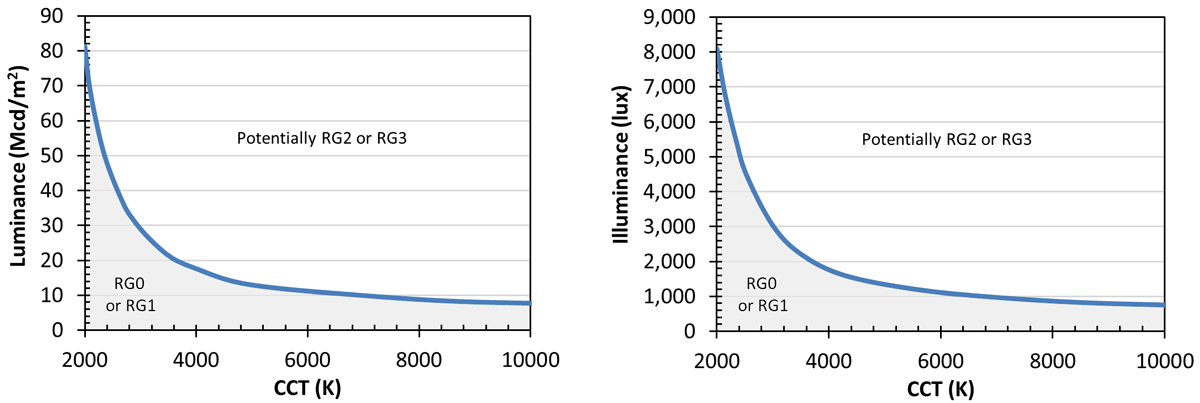
Calculated threshold conditions for white light source classification as RG2 or higher (Source: Optical Safety of LEDs by U.S. Department of Energy)
Just because most LEDs have a blue peak in their SPDs or they're blue-pumped doesn't mean they necessarily have more potential to incur blue light damage to the retina. The blue light hazard weighting function ranges from 400 nm to 500 nm, rather than on a single wavelength or local peak. Accordingly, calculating the total energy in the wavelength band that can photochemically induce retinal injury makes more sense than judging BLE by the height of the spectral peak. In September 2018 IES reinforced DOE's point of view by comparing the blue light content of different light sources. At the same CCT and illuminance level, the blue content (over the range between 400 nm and 490 nm) of the LED lamp is 16.6%, the fluorescent lamp is 18.4%, and the HID lamp is 24.0%.
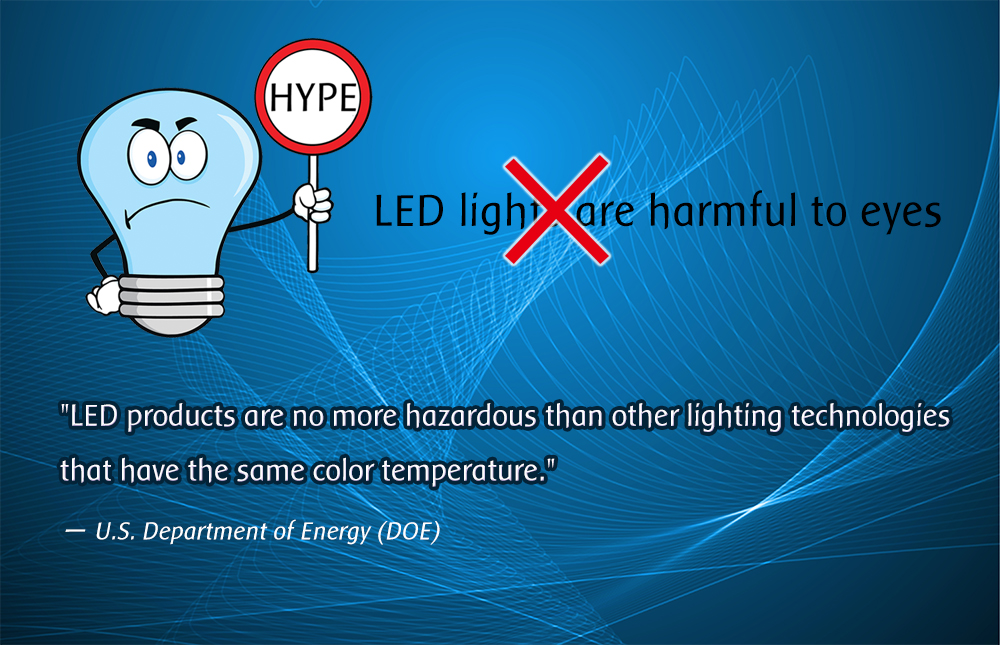
Despite the fact that LED lighting is photobiologically safe as other types of light sources, care should be taken for applications where infants and children could be in close proximity to unshielded high CCT LED light source. LEDs are concentrated sources of directional light. Infants and children cannot efficiently filter out blue light with the lenses of their eyes and they have not yet developed aversion responses to prevent them from direct viewing of the high intensity light source.
Of course, LEDs made using different packaging techniques may have varied amounts of short wavelength light at the same CCT. LEDs can have a lower or higher percentage of blue in its spectrum than other types of light sources. One thing is for sure, warm white (3000 K or less) and neutral white (around 3500 K) LEDs have a significantly lower amount of blue content than cool white LEDs at CCT extremes (5000 - 6500 K). Some lighting manufacturers deliberately use extremely high CCT LEDs just for a good parameter of luminous efficacy in their spec sheet or to make people feel that their lights are bright. For these manufacturers, the spectral quality of an LED light source is never on their list of considerations.
Our suggestion is to stay away from high CCT lighting with whatever the light source in indoor applications, especially during the nighttime. Rather than being concerned about photobiochemical safety of white light sources, the human world should pay more attention to the biological effects of light. The total energy in the blue wavelength band of a light spectrum is closely tied to your health and well-being. Rather than being excessively worried about the blue light hazard of LED lighting, read on to find if your lighting is appropriately attuned to your circadian rhythm.
Our master biological clock is located in the suprachiasmatic nuclei (SCN) of the hypothalamus of the brain. SCN regulates the secretion or suppression of melatonin, cortisol and serotonin, which are responsible for our sleep-wake pattern. The retina of the eye contain three photoreceptors (rods, cones and ipRGCs) which convert light into electrical signals for the circadian system through circadian phototransduction. Although the visual photoreceptors rods and cones participate in circadian phototransduction, it's the non-visual photoreceptor, the intrinsically photosensitive retinal ganglion cell (ipRGC), that governs the process of integrating and transmitting photic information via the retino-hypothalamic tract (RHT) directly to the SCN, thereby entraining the circadian system to the 24-hour cycle of the solar day.
In 1998 scientists discovered it is a photopigment called melanopsin that mediates the non-visual response of ipRGCs. Melanopsin reacts only to the blue wavelengths and has peak photosensitivity in the 459 - 484 nm range. Throughout the day, blue-rich daylight signals the SCN via circadian phototransduction to release cortisol, dopamine and serotonin to create sensations of pleasure, vitality, alertness, concentration and coordination while suppressing melatonin release to reduce daytime drowsiness. The term "blue rich light" refers to white light with a cool cast (4000 K or greater). As the sun sets, the daylight turns stronger in the red part of the spectrum and we call it warm white (2700 - 3000 K). The blue light percentage in the evening ambiance is drastically reduced and the potosensitivity of ipRGCs falls accordingly. The production of cortisol in the body declines significantly and the release of melatonin is gradually unlocked.
Melatonin is a critically important hormone which synchronizes the peripheral clocks with the SCN, promotes a better quality of restorative sleep, and contributes to a vital protective mechanism for suppression of cancer cell development. Warm white light with relatively low brightness stimulates the release of melatonin and allows the human body to wind down and relax. Melatonin secretion in the absence of blue light or under conditions of darkness starts to climb around 9 P.M. and peaks around 2 A.M.
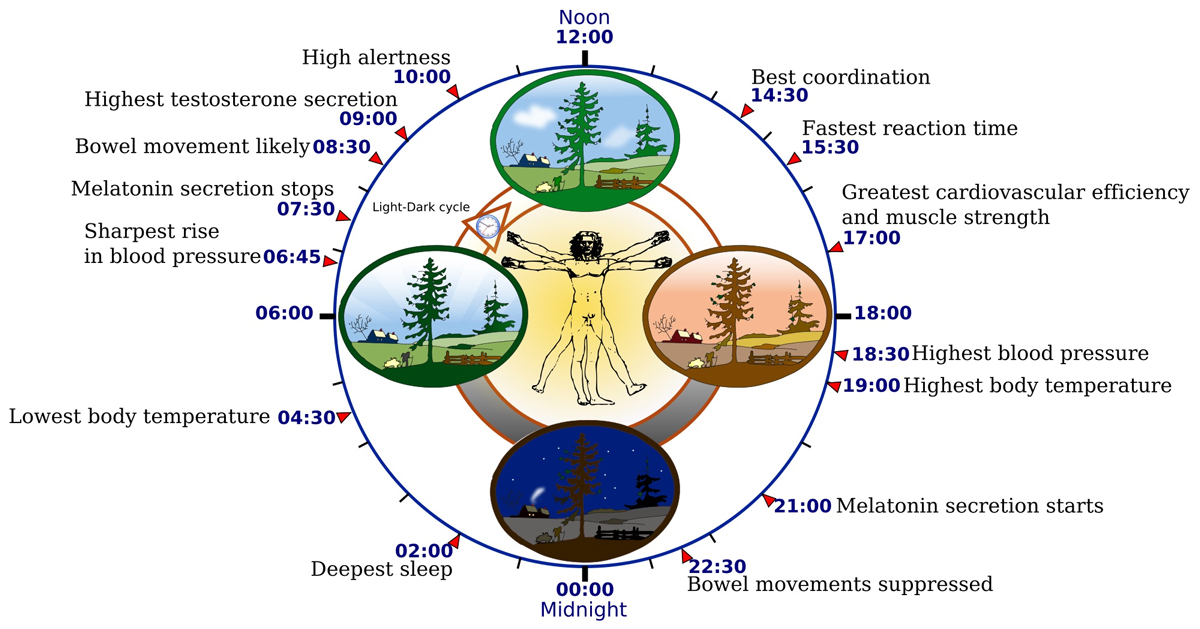
Nocturnal exposure to blue-enriched light causes the body to simulate a daytime physiological response. This can disrupt the natural circadian rhythm that the human being has developed during the process of evolution. Circadian disruption puts people at risk of various health consequences such as sleep disorders, mood disorders, cancer pathologies, cardiovascular diseases, and reproductive problems. Thus, the ties between light and our overall health can’t afford to be ignored. Artificial lighting should simulate the spectral quality and light intensity of natural daylight over the course of the day to keep our endogenous circadian rhythms tuned to the natural light-dark cycle.
The color temperature is highly predictive of the blue light content of a light source (The higher the CCT, the higher the blue light content, and the light color shifts from a relatively reddish tone to a relatively bluish tone.)
As there's a strong correlation between blue light content and color temperature, the science behind circadian lighting can be distilled to color temperature selection. Warm white LEDs, like other types of light sources, have a very limited amount of blue wavelengths in their radiant energy and therefore don't suppress the release of melatonin during the nighttime. However, a large population in the world are exposed to high CCT light emitted from cool white LEDs at night. Nighttime exposure to optical radiation with a high bioactive blue dosage from 4000 - 6500 K LEDs or other cool white light sources is the same as a second time exposure to sunlight at night. The circadian system has to reset biological clocks to adapt itself to the interior environment. The discrepancies over the long term between our endogenous circadian rhythm – our internal body clock – and our genetically inherited external day/night rhythm will eventually impair our health.
Both the lighting industry and the consumer world turn a blind eye to the importance of color temperature selection for interior lighting. It seems lighting designers are the only educated group that incorporates human centric lighting into their designs. Unfortunately their scope of influence is limited to commercial lighting projects and the high end residential lighting market.
The focus was misplaced on LED lighting. If online opinion leaders are crazy to find a scapegoat of circadian disruption, have a look back on the fluorescent technology of which the only benefit is energy efficiency. The introduction of fluorescent lighting was a disaster with regard to circadian lighting, especially in home lighting: suddenly the nighttime ambiance in every home in the world turns from the warm, relaxing and circadian-friendly glow of incandescent lighting to the cold, uncomfortably bright, and circadianly disruptive cast from fluorescent lamps.
Although fluorescent lighting is being phased out, many populations have adapted themselves to the fluorescent cool white. The lighting market in China, for example, has a strong preference for high color temperature (6000 - 6500 K) light sources for every application, including nighttime illumination in residences. Being the largest supplier country to the world lighting market, its high CCT preference is getting spread around the world with its products.

Optical Radiation Hazards
Light is defined as optical radiation of which the electromagnetic spectrum consists of three bands: ultraviolet (UV) radiation from 100 nm to 380 nm, visible light from 380 nm to 780 nm, and infrared (IR) radiation from 780 to 10,000 nm. Optical radiation falls on the outer layers of the body (mostly skin and eyes), where the radiant energy is absorbed and transformed via photochemical processes or thermal reactions. While this sensory interaction is vital for the human perception of the physical world, excessive exposure to optical radiation may have adverse effects. In humans, exposure to sunlight or artificial light can potentially lead to various types of photobiological reactions, including:- Ultraviolet photochemical injury to the cornea (photokeratitis) (180 - 400 nm).
- Ultraviolet cataract (clouding of the lens in the eye) due to chronic exposure (290 - 325 nm, 305 nm peak).
- Ultraviolet erythema (reddening of the skin) (200-320 nm, 295 nm peak).
- Retinal thermal injury caused by acute exposure to 400 - 1,400 nm wavelengths at extreme intensities.
- Blue light photochemical injury to the retina (400 - 500 nm).
- Near-infrared thermal damage of the crystalline lens (approximately 800 to 3,000 nm).
- Infrared cataract (clouded vision as a result of a photobiological effect, and also possibly a photochemical reaction) (700 - 1400 nm).
- Thermal injury (burns) of the cornea and conjunctiva (approximately 1,400 nm to 1 mm).

Image courtesy of 3M Company
Why Is LED Technology under Unprecedented Scrutiny with Regard to Human Health
LEDs produce optical radiation within the visible range of the electromagnetic spectrum — no emission in the UV part of the spectrum, hardly any ultraviolet radiation, and no radiated heat. Therefore LED lighting has the least risk factors when compared with other types of light sources including incandescent, halogen, fluorescent, metal halide and mercury vapor lamps. Among the above-mentioned optical radiation hazards, the only one that is practically applicable to LEDs is blue light hazard which universally exists in all white light sources. Nonetheless, there's a huge uncertainty about the safety of LED optical radiation among many people. And this uncertainty has been mainly stirred up by online opinion leaders who had little research into this topic but rushed to draw a conclusion just to create a sensation.As semiconductor devices, LEDs were originally included in the scope of the laser safety standard IEC 60825 in Europe and other IEC oriented countries, which gave a misconception that LED lighting was as dangerous as laser lighting and thus often led to an overestimation of the risks. Since 2009 LEDs are tested to the IEC 62471 standard as with all other lamps and luminaires.
The main ground of those misinformed claims is that the electromagnetic spectrum of blue-pump LEDs has a narrow peak in the short wavelength blue region. This blue peak, which is more prominent in higher-CCT LEDs, can be easily misinterpreted as suggesting an abnormally high blue content.
What Are Blue-pump LEDs
LEDs are not inherently white light sources, bare LED dies (chips) emit in narrow spectral bands, resulting in a colored monochromatic radiation, such as red, blue or green, depending on the chemical composition of the semiconductor. There're two methods available to produce white light with monochromatic LEDs: phosphor conversion (PC) and additive color mixing. The phosphor-converted LED utilizes a blue LED to pump phosphors within the device package. The combination of blue from the LED and yellow from the phosphor creates white light. Hence phosphor-converted LEDs are called blue-pump LEDs. Compared with the color mixing method which creates white light by mixing primary color light from three individual LEDs (red, green, blue), phosphor conversion boasts higher luminous efficacy, temperature robustness (CCT flexibility) and color stability. The simplicity in device architecture allows for cost-efficient mass production. Blue-pump LEDs are by far the dominant white LED light source used in general lighting applications. Therefore, the term "LEDs" is often interchangeable with "blue-pump LEDs".
Lamp Safety Groups
Before we continue the talks on the optical radiation hazards of LEDs, let's have a look at the classification scheme of lamp hazards degrees. The International Electrotechnical Commission (IEC) and the Illuminating Engineering Society (IES) have developed very similar standards to communicate the overall level of risk of a light source. Lamps or lamp systems are evaluated at a distance corresponding to an illuminance of 500 lux and categorized into 4 groups according to the degree of photobiological hazard associated with them. Here's an IES version of lamp safety classifications (source: ANSI/IES RP-27.3-17).Risk Group 0 (RG0, Exempt Group)
The lamp poses no photobiological hazard. The requirement is met by any lamp that does not pose an actinic ultraviolet hazard within 8 hours' exposure, nor a near-ultraviolet hazard nor an infrared cornea/lens hazard within 1,000s, nor retinal thermal hazard within 10 s, nor a blue-light hazard within 10,000 s (about 2.8 hours), and lamps that emit infrared radiation without a strong visual stimulus and do not pose a near-infrared retinal hazard within 1,000 s are in the Exempt group.
Risk Group 1 (RG1, Very Low Risk)
The lamp does not pose a photobiological hazard under normal behavioral limitations. This requirement is met by any lamp that exceeds the limits for the Exempt Group but that does not pose an actinic ultraviolet hazard within 10,000 s (i.e., about 2.8 hrs.), nor a near ultraviolet hazard within 300 s, nor a blue light hazard, nor an infrared cornea/lens hazard within 100 s, nor a retinal thermal hazard within 10 s, and these lamps are in Risk Group 1. Also, lamps that emit infrared radiation without a strong visual stimulus and do not pose a near-infrared retinal hazard, within 100 s are in Risk Group 1.Risk Group 2 (RG2, Low Risk)
The lamp does not pose a hazard due to aversion response (blinking, head movement, and pupil constriction) to bright light or thermal discomfort. This requirement is met by any lamp that exceeds the limits for Risk Group 1 (Very Low Risk), but that does not pose an actinic ultraviolet hazard within 1,000 s exposure, nor a near ultraviolet hazard within 100 s, nor an infrared cornea/lens hazard within 10 s, nor a retinal thermal hazard, nor a blue light hazard within 0.25 s (aversion response), are in Risk Group 2. Also, lamps that emit infrared radiation without a strong visual stimulus and do not pose a near infrared retinal hazard within 10 s are in Risk Group 2.Risk Group 3 (RG3, High Risk)
The lamp may pose a hazard even for momentary or brief exposure. Lamps that exceed the limits for Risk Group 2 (Low Risk) are in Risk Group 3.What Is Blue Light Hazard
In fact, LED lighting has much less risk factors than traditional technologies. LEDs produce no infrared radiation and emit a negligible amount of UV light—less than 5 uW/lm, whereas traditional light sources generate a considerable amount of IR light as well as UV emission—incandescent (70-80 uW/lm), tungsten-halogen (40-170 uW/lm), fluorescent (30-100 uW/lm), and metal halide (160-700 uW/lm).Because of the UV- and IR-free spectral nature of LED optical radiation, the only assessed item for LED lamps and light fixtures in IEC/IES lamp safety classifications is blue light hazard. Blue light hazard (BLH) is defined as the potential for a photochemically induced retinal injury resulting from radiation exposure to high-energy, short-wavelength light in the violet and blue range of the spectrum (between 400 and 500 nm). Blue light radiation on the eye can induce production of reactive oxygen species (ROS) which attacks many molecules, including retinal pigment epithelium (RPE) cells that are essential to the regeneration of visual pigments, supply the photoreceptors with nutrients and oxygen, and help maintain the homeostasis of photoreceptors. Excessive oxidative stress leads to RPE apoptosis which eventually causes the rod and cone photoreceptors to degenerate. Blue light photoactivation has been implicated in the pathogenesis of age-related macular degeneration (AMD), a degenerative retinal disease.
By far the most hazardous light source is the sun, which not only produces optical radiation in both the infrared and ultraviolet regions of the electromagnetic spectrum, but also contains a high percentage of blue (25% - 30% of the total radiant energy) in its visible light spectrum. When looking directly into the sun, a photochemical damage to the retina is likely to occur. Fortunately, we have natural aversion responses that protect the eye against injury from viewing very bright light. There's a threshold radiance, irradiance, and duration of exposure for oxidative photoactivation of blue light. For example, the blue wavelengths of sunlight gives the sky its blue appearance, but there's no risk of retinal injuries exposing the eye to skylight because the scattered blue light in skylight isn't potent enough to induce photochemical reaction in the retina.
Do LEDs Emit More Blue Light? No!
The distinct blue peak in the spectral power distribution (SPD) of most blue-pump LEDs gives opinion leaders the justification to support their claims. As early as in 2013, the U.S. Department of Energy (DOE) made this very clear in its fact sheet Optical Safety of LEDs that LED products are no more hazardous than other lighting technologies that have the same correlated color temperature (CCT), and the proportion of blue light in the spectrum is not significantly higher for LEDs than it is for any other light source at the same CCT.
Source: Optical Safety of LEDs by U.S. Department of Energy
Most people don't take the color temperature of a light source seriously. In fact, the role of CCT in lighting is far more important than most people would ever imagine. Not only does it visually and psychologically affect the illuminated environment, the choice of CCT, together with light intensity, establishes the photobiological damage potential of a light source. Light at any given wavelength, including the short wavelength blue, is the same regardless of what the light source emitted from. On the whole, the higher the CCT is, the more blue light content is contained in the spectrum, be it LED, fluorescent, or HID lamps. There's evidently a strong linear correlation between blue light damage potential and CCT regardless of the source type. According to IEC TR 62778, the threshold for illuminance that potentially contributes to an RG2 hazard is around 1000 lux for a 6500 K cool white light source, and 5000 lux for a 2700 K warm white light source. The threshold for luminance that may lead to a hazard classification of RG2 is 10 Mcd/m2 for a 6500 K cool white light source, and 32 Mcd/m2 for a 2700 K warm white light source.

Calculated threshold conditions for white light source classification as RG2 or higher (Source: Optical Safety of LEDs by U.S. Department of Energy)
Just because most LEDs have a blue peak in their SPDs or they're blue-pumped doesn't mean they necessarily have more potential to incur blue light damage to the retina. The blue light hazard weighting function ranges from 400 nm to 500 nm, rather than on a single wavelength or local peak. Accordingly, calculating the total energy in the wavelength band that can photochemically induce retinal injury makes more sense than judging BLE by the height of the spectral peak. In September 2018 IES reinforced DOE's point of view by comparing the blue light content of different light sources. At the same CCT and illuminance level, the blue content (over the range between 400 nm and 490 nm) of the LED lamp is 16.6%, the fluorescent lamp is 18.4%, and the HID lamp is 24.0%.
The Exaggerated BLH Concern
The blue light hazard of LED lighting is overly stressed. The amount of blue light radiated from various light sources, including LED, in typical indoor lighting applications is not hazardous. For those who are excessively concerned with blue light hazard, consider the fact that, as IES points out, indirect sunlight renders us exposed to 27 times as much blue light as optical radiation from LEDs at typical indoor lighting levels. In fact, we may be exposed to more blue light radiation from electronic devices such as computers, tablets and smart phones. The color schemes for mobile and computer games are usually abundant in blue wavelengths, which poses a greater BLE damage potential to the eye. Importantly, the risk groups are established on the principle that optical radiation must exceed the threshold for both the luminance and illuminance conditions. The RG2 classification for blue light hazard is for maximum exposure times between 100 seconds and 10,000 seconds. Humans' natural aversion responses to very bright light would likely limit the duration of focused exposure to much less than a few seconds. An absolute majority of visually demanding tasks are performed at an illuminance level between 200 - 600 lux, which is well below the threshold (1000 lux for a 6500 K cool white light source) that potentially contributes to an RG2 hazard. Therefore a blue light hazard classification of RG2 and RG3 for white light sources is very unlikely even with high CCT lighting.
Despite the fact that LED lighting is photobiologically safe as other types of light sources, care should be taken for applications where infants and children could be in close proximity to unshielded high CCT LED light source. LEDs are concentrated sources of directional light. Infants and children cannot efficiently filter out blue light with the lenses of their eyes and they have not yet developed aversion responses to prevent them from direct viewing of the high intensity light source.
Of course, LEDs made using different packaging techniques may have varied amounts of short wavelength light at the same CCT. LEDs can have a lower or higher percentage of blue in its spectrum than other types of light sources. One thing is for sure, warm white (3000 K or less) and neutral white (around 3500 K) LEDs have a significantly lower amount of blue content than cool white LEDs at CCT extremes (5000 - 6500 K). Some lighting manufacturers deliberately use extremely high CCT LEDs just for a good parameter of luminous efficacy in their spec sheet or to make people feel that their lights are bright. For these manufacturers, the spectral quality of an LED light source is never on their list of considerations.
Our suggestion is to stay away from high CCT lighting with whatever the light source in indoor applications, especially during the nighttime. Rather than being concerned about photobiochemical safety of white light sources, the human world should pay more attention to the biological effects of light. The total energy in the blue wavelength band of a light spectrum is closely tied to your health and well-being. Rather than being excessively worried about the blue light hazard of LED lighting, read on to find if your lighting is appropriately attuned to your circadian rhythm.
Blue Light Is Vital
Blue light is definitely not as horrible as you might have heard. In the course of human evolution, our body is naturally programed to cycle with the sequence of day and night via light exposure. Blue is an essential part of the SPD of natural daylight and plays a key role in setting our master biologic clock which establishes the circadian rhythm, a 24-hour biological process that rhythmically regulates the functioning of our physiological and behavioral systems. Circadian rhythms can influence sleep/wake cycles, hormone release, digestion, body temperature, blood pressure, alertness, and cognitive performance.Our master biological clock is located in the suprachiasmatic nuclei (SCN) of the hypothalamus of the brain. SCN regulates the secretion or suppression of melatonin, cortisol and serotonin, which are responsible for our sleep-wake pattern. The retina of the eye contain three photoreceptors (rods, cones and ipRGCs) which convert light into electrical signals for the circadian system through circadian phototransduction. Although the visual photoreceptors rods and cones participate in circadian phototransduction, it's the non-visual photoreceptor, the intrinsically photosensitive retinal ganglion cell (ipRGC), that governs the process of integrating and transmitting photic information via the retino-hypothalamic tract (RHT) directly to the SCN, thereby entraining the circadian system to the 24-hour cycle of the solar day.
In 1998 scientists discovered it is a photopigment called melanopsin that mediates the non-visual response of ipRGCs. Melanopsin reacts only to the blue wavelengths and has peak photosensitivity in the 459 - 484 nm range. Throughout the day, blue-rich daylight signals the SCN via circadian phototransduction to release cortisol, dopamine and serotonin to create sensations of pleasure, vitality, alertness, concentration and coordination while suppressing melatonin release to reduce daytime drowsiness. The term "blue rich light" refers to white light with a cool cast (4000 K or greater). As the sun sets, the daylight turns stronger in the red part of the spectrum and we call it warm white (2700 - 3000 K). The blue light percentage in the evening ambiance is drastically reduced and the potosensitivity of ipRGCs falls accordingly. The production of cortisol in the body declines significantly and the release of melatonin is gradually unlocked.
Melatonin is a critically important hormone which synchronizes the peripheral clocks with the SCN, promotes a better quality of restorative sleep, and contributes to a vital protective mechanism for suppression of cancer cell development. Warm white light with relatively low brightness stimulates the release of melatonin and allows the human body to wind down and relax. Melatonin secretion in the absence of blue light or under conditions of darkness starts to climb around 9 P.M. and peaks around 2 A.M.

Rhythm of Life (Image courtesy of Yassine Mrabet)
Artificial Lighting and Circadian Disruption
As presented above, the human being needs blue light radiation to support the daytime activities. Conversely at night, exposure to white light with a high percentage of blue will suppress melatonin secretion. In today's world however, people spend about most of their time indoors. The dynamic changes in the spectral composition and intensity of natural daylight are not reflected in artificial lighting. Our bodies receive uniform and consistent optical radiation from artificial light sources. The natural lighting cycles of the sun is not perceived anymore. What's worse is that, while cool white light is necessary in offices, workplaces and schools for enhanced learning performance or work efficiency, a large number of uneducated consumers in the world are exposed to cool white light in their homes during the nighttime when warm white should be the tone of light to encourage relaxation and regeneration. And the cool white light sources in many countries have a soaring high CCT (6000 - 6500 K), which leads to acute melatonin suppression due to the high percentage of blue in the light spectrum.Nocturnal exposure to blue-enriched light causes the body to simulate a daytime physiological response. This can disrupt the natural circadian rhythm that the human being has developed during the process of evolution. Circadian disruption puts people at risk of various health consequences such as sleep disorders, mood disorders, cancer pathologies, cardiovascular diseases, and reproductive problems. Thus, the ties between light and our overall health can’t afford to be ignored. Artificial lighting should simulate the spectral quality and light intensity of natural daylight over the course of the day to keep our endogenous circadian rhythms tuned to the natural light-dark cycle.
The color temperature is highly predictive of the blue light content of a light source (The higher the CCT, the higher the blue light content, and the light color shifts from a relatively reddish tone to a relatively bluish tone.)
| Color temperature | Reference light source |
|---|---|
| 1700 / 1800 K | Match/candle flame, low pressure sodium lamps |
| 2000 / 2200 K | Sunlight at sunrise and sunset |
| 2700 K | Warm white LEDs and fluorescent lamps |
| 2856 K | Standard incandescent lamps |
| 3000 K | Tungsten-halogen (quartz) lamps |
| 3200 K | Dusk/dawn, high power halogen lamps |
| 3500 K | Neutral white LEDs, HID and fluorescent lamps |
| 4000 K | Sunlight in early morning and late afternoon |
| 4500 K | Sunlight in mid-morning and mid-afternoon |
| 5000 K | Sunlight in late morning and early afternoon |
| 5500 K | Noon sunlight on a clear day |
| 6000 K | Shade in daylight |
| 6500 K | Noon sunlight on an overcast day |
| 8000 K | Dark overcast sky |
| 10000 - 12000 K | Blue sky |
LED Lighting Should Not Be the Scapegoat of Circadian Disruption
Again, LED technology has been blamed for causing circadian disruption. This is a ridiculous criticism because circadian disruption is fundamentally not correlated to LED technology. Critics usually made this claim out of the sheer ignorance of the science behind circadian lighting. Circadian lighting works on adjusting quantity and spectrum of interior lighting to reflect the dynamics of natural daylight. Bright, biologically effective light with a high percentage of blue in the spectrum makes people alert, concentrated, productive and motivated in working and learning environments during the daytime. At night, warm, blue-depleted light helps create a relaxing atmosphere for regeneration and signals the SCN to release melatonin for a more refreshing sleep.As there's a strong correlation between blue light content and color temperature, the science behind circadian lighting can be distilled to color temperature selection. Warm white LEDs, like other types of light sources, have a very limited amount of blue wavelengths in their radiant energy and therefore don't suppress the release of melatonin during the nighttime. However, a large population in the world are exposed to high CCT light emitted from cool white LEDs at night. Nighttime exposure to optical radiation with a high bioactive blue dosage from 4000 - 6500 K LEDs or other cool white light sources is the same as a second time exposure to sunlight at night. The circadian system has to reset biological clocks to adapt itself to the interior environment. The discrepancies over the long term between our endogenous circadian rhythm – our internal body clock – and our genetically inherited external day/night rhythm will eventually impair our health.
Both the lighting industry and the consumer world turn a blind eye to the importance of color temperature selection for interior lighting. It seems lighting designers are the only educated group that incorporates human centric lighting into their designs. Unfortunately their scope of influence is limited to commercial lighting projects and the high end residential lighting market.
The focus was misplaced on LED lighting. If online opinion leaders are crazy to find a scapegoat of circadian disruption, have a look back on the fluorescent technology of which the only benefit is energy efficiency. The introduction of fluorescent lighting was a disaster with regard to circadian lighting, especially in home lighting: suddenly the nighttime ambiance in every home in the world turns from the warm, relaxing and circadian-friendly glow of incandescent lighting to the cold, uncomfortably bright, and circadianly disruptive cast from fluorescent lamps.
Although fluorescent lighting is being phased out, many populations have adapted themselves to the fluorescent cool white. The lighting market in China, for example, has a strong preference for high color temperature (6000 - 6500 K) light sources for every application, including nighttime illumination in residences. Being the largest supplier country to the world lighting market, its high CCT preference is getting spread around the world with its products.



